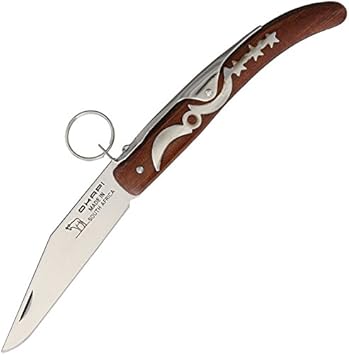Let me begin by saying that I love the concept of Andrew Demko's design called the Scorpion Lock.It's a bit of a refreshing approach these days to these stout/grip enforced lock designs putting some creative against omega spring based designs.Spending some time with some with my Cold Steel AD-15 and came to the conclusion that it's a reverse engineered lockback.In terms of the reversal of the pivot point to lift the bar and of course you pull up where the bolt interacts with the blade instead.
Though modified and brought into the modern knife era for use I see a lot of similarities between Andrew's design...and an old patented one from long ago.Here's the patent...
https://patents.google.com/patent/US4040181A/en
This design was created for Western's lockback line back in the 70's for their WestLock models.The design was created to house the lockback spring in a cavity to shield off dirt build up and resist the elements as one whole single piece.You'll also notice the pivot point sits much higher than other lockbacks.Reversing the pivot point on the Scorpion Lock makes this lock operate in a completely different manner.The original design by Lawrence Johnson had limitations in it's space eating design for a lockback so this is why Andrew mills out the yoke(lockback lever really) to allow the blade to seat deeper in the handle.Going this route obviously required a heavily coiled spring in the cavity region for the yoke's resistance at lifting it upwards.
I like the design of the Scorpion Lock altogether but as an older guy it's something retro I familiarize it with greatly.But a design completed dreamed up out of thin air?...it certainly is not.
Though modified and brought into the modern knife era for use I see a lot of similarities between Andrew's design...and an old patented one from long ago.Here's the patent...
https://patents.google.com/patent/US4040181A/en
This design was created for Western's lockback line back in the 70's for their WestLock models.The design was created to house the lockback spring in a cavity to shield off dirt build up and resist the elements as one whole single piece.You'll also notice the pivot point sits much higher than other lockbacks.Reversing the pivot point on the Scorpion Lock makes this lock operate in a completely different manner.The original design by Lawrence Johnson had limitations in it's space eating design for a lockback so this is why Andrew mills out the yoke(lockback lever really) to allow the blade to seat deeper in the handle.Going this route obviously required a heavily coiled spring in the cavity region for the yoke's resistance at lifting it upwards.
I like the design of the Scorpion Lock altogether but as an older guy it's something retro I familiarize it with greatly.But a design completed dreamed up out of thin air?...it certainly is not.

